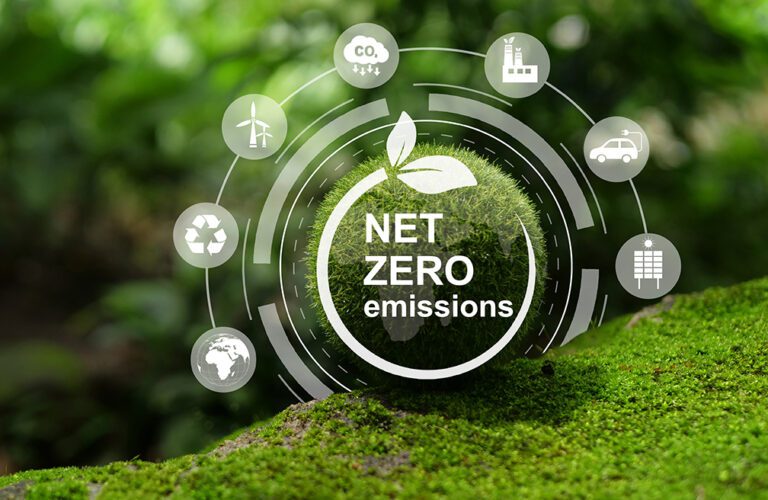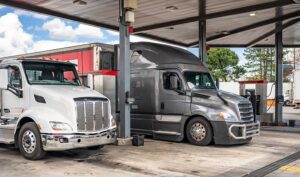The September 2022 signing of a memorandum of understanding (MOU) by leaders of the U.S. departments of Energy, Transportation, Housing and Urban Development, and the Environmental Protection Agency was historic because of its interdepartmental commitment to cooperation. The MOU outlined some lofty goals, including achieving net-zero emissions “economy-wide” no later than the year 2050.
The MOU notes that “the transportation sector is responsible for more GHG (greenhouse gas) emissions than any other sector” and must play a leading role in achieving the goals outlined in the document.
With that emphasis on transportation, the U.S. National Blueprint for Transportation Decarbonization (the Blueprint) was released in January 2023. Ann Rundle, vice president of Electrification and Autonomy at ACT Research, welcomed the concept.
“My first reaction was, ‘Hello, thank you very much,’” she said. “Finally, we’ve got not just the Department of Transportation looking at something or the Department of Energy; these agencies all interact.”
The details in the Blueprint are vague. Terms like, “administer forward-looking policy,” “leverage technology,” and “encourage greater use of” appear throughout the Blueprint unaccompanied by any specific steps planned to reach targets.
The Blueprint is, however, a framework with an identifiable goal: To eliminate carbon emissions by 2050.
To be sure, the trucking industry has made great progress in reducing emissions of carbon and other pollutants. Caitlin Smith, manager of government affairs for the Truckload Carriers Association (TCA), commented on the role of TCA members in supporting the effort.
“TCA is immensely proud of the incredible strides the truckload industry has made thus far to reduce greenhouse gas emissions and the investment currently underway to continue that ever-important work,” she said.
The industry will undoubtedly continue to work with available technology to further reduce or eliminate harmful emissions. However, whether the technology will be advanced enough to achieve the Blueprint’s goals of full decarbonization by 2050 is questionable.
The current frontrunner for decarbonization is the battery-electric vehicle. According to ACT’s Rundle, advancements in battery electric vehicles are the reason.
“Battery and battery technology is improved so much over the last eight years,” she said. “A great example is the Nissan LEAF from (the) 2012 or 2013 model year. The same vehicle a couple of years ago had three times the range (of the original). Size, battery, and similar cost.”
Rundle spoke about improvements in energy density in batteries.
“Today we’re in the neighborhood of 260 watt hours per kilogram,” she explained. “With lithium sulfur, we’re up to 600. So, we’re gonna get double the improvement in energy density. We know we can probably do that by the 2040 time frame.”
Rumors that lithium is in short supply are unfounded, she said.
“In 2021 production, we were using four-tenths of 1% of the world lithium reserves — a drop in the bucket,” she said.
Rundle maintains that the advances in electric power for light vehicles will eventually be used in heavy-duty vehicles as well. The problem won’t be battery storage or power, however; it will be producing the clean electricity used to charge them.
“You’ve got your dirty grid,” she said. “Are you just transferring a CO2 issue downstream?”
Even though the Department of Energy (DOE) is a signatory to the MOU, the agency’s Energy Information Administration (EIA) statistical arm is not predicting success. In the 2022 Annual Energy Outlook published in March 2022, the EIA predicted petroleum products and natural gas will still be the most-consumed energy sources in year 2050, just as they are today. Although the Blueprint specifies the use of 100% renewable energy for electricity generation by 2050, the EIA Outlook predicts that only 36% will be renewable. EIA projections are that 10% of the electricity will come from coal and 34% from natural gas in 2050.
Rundle points out that carbon capture could be used to help reach the net-zero goal, but she’s skeptical.
“Carbon capture today is even less of a developed industry than renewables,” she said.
The Bipartisan Infrastructure Law, passed in November 2021, earmarks $65 billion for an upgrade to the nation’s power grid, including investment in clean energy technologies. Perhaps the 2023 EIA Annual Energy Outlook will incorporate anticipated changes into its projections.
While the Blueprint looks to battery power for light-duty and short-haul heavy-duty vehicles, a different clean energy source is suggested for long-haul heavy trucks — hydrogen. That’s problematic, according to Rundle.
“The overall efficiency of a battery electric (vehicle) is 73%,” Rundle explained. Some energy is consumed in the transmission and distribution of electricity, more in the charging process and powering inverters, so only about 73% of the energy sent from the generation facility is used to power the vehicle.
“With a fuel cell, you’re going to end up with 30% at best,” she continued. “The energy losses in a fuel cell versus battery electric are much greater. That is physics you cannot get around.”
The cost of hydrogen — and the durability of the fuel cells — are additional issues.
Another option for hydrogen as a power source is using it in an internal combustion engine, much the way diesel fuel is burned today. The problem is that burning hydrogen is about as inefficient as burning diesel.
There’s another issue.
“Where are we going to get all this green hydrogen?” Rundle asked, pointing out that some people already claim that the power grid can’t handle electric vehicle charging, while no “grid” exists for distribution of hydrogen.
Currently, hydrogen is manufactured by splitting water into the elements that make it up, hydrogen and oxygen.
“You look at what regions of the world can easily readily produce green hydrogen, and it’s limited because you need to have access to clean, fresh water,” she said. “You have to have access to renewable energy, and you also have to be able to transport it.”
One potential solution may be found in recent advances in the production of hydrogen from ammonia. Decomposing ammonia results in clean hydrogen and nitrogen. The process might be done onboard a vehicle, with the hydrogen produced going directly to a fuel cell for power. Ammonia is inexpensive to produce and doesn’t need pressurization for storage.
The hazardous nature of ammonia and the potential for nitrogen oxygen (NOX) production in the decomposition process are issues that will need to be worked out to make the practice viable for vehicle fuels.
For now, battery electric trucks are the most likely solution to eliminating carbon emissions from trucking. However, significant advances in electricity production and storage will be needed if the U.S. is to reach the goal of zero emissions by the year 2050.
This article originally appeared in the March/April 2023 edition of Truckload Authority, the official publication of the Truckload Carriers Association.
Cliff Abbott is an experienced commercial vehicle driver and owner-operator who still holds a CDL in his home state of Alabama. In nearly 40 years in trucking, he’s been an instructor and trainer and has managed safety and recruiting operations for several carriers. Having never lost his love of the road, Cliff has written a book and hundreds of songs and has been writing for The Trucker for more than a decade.















